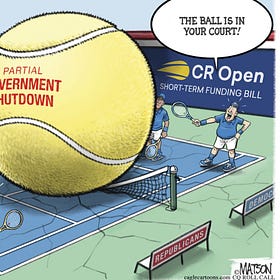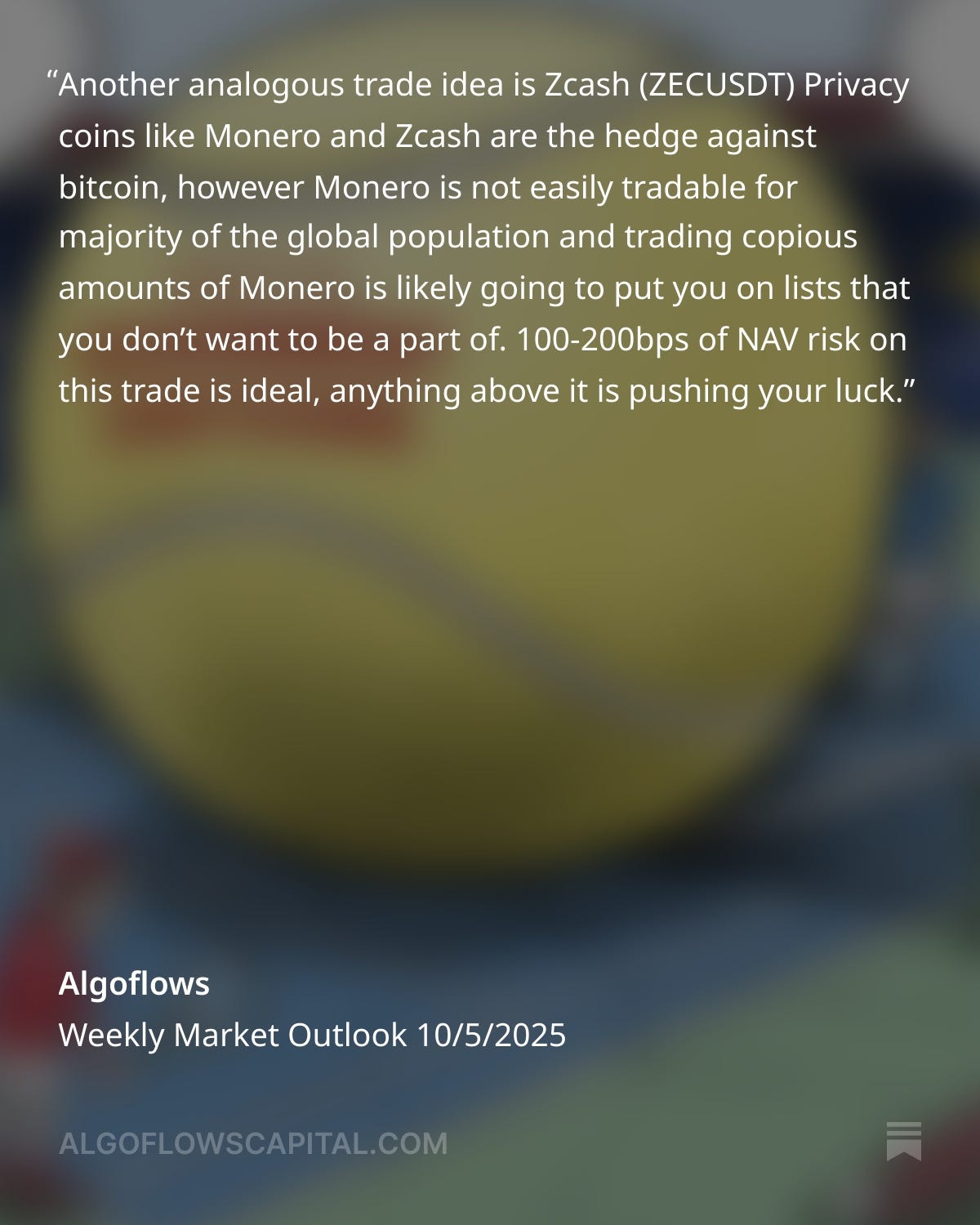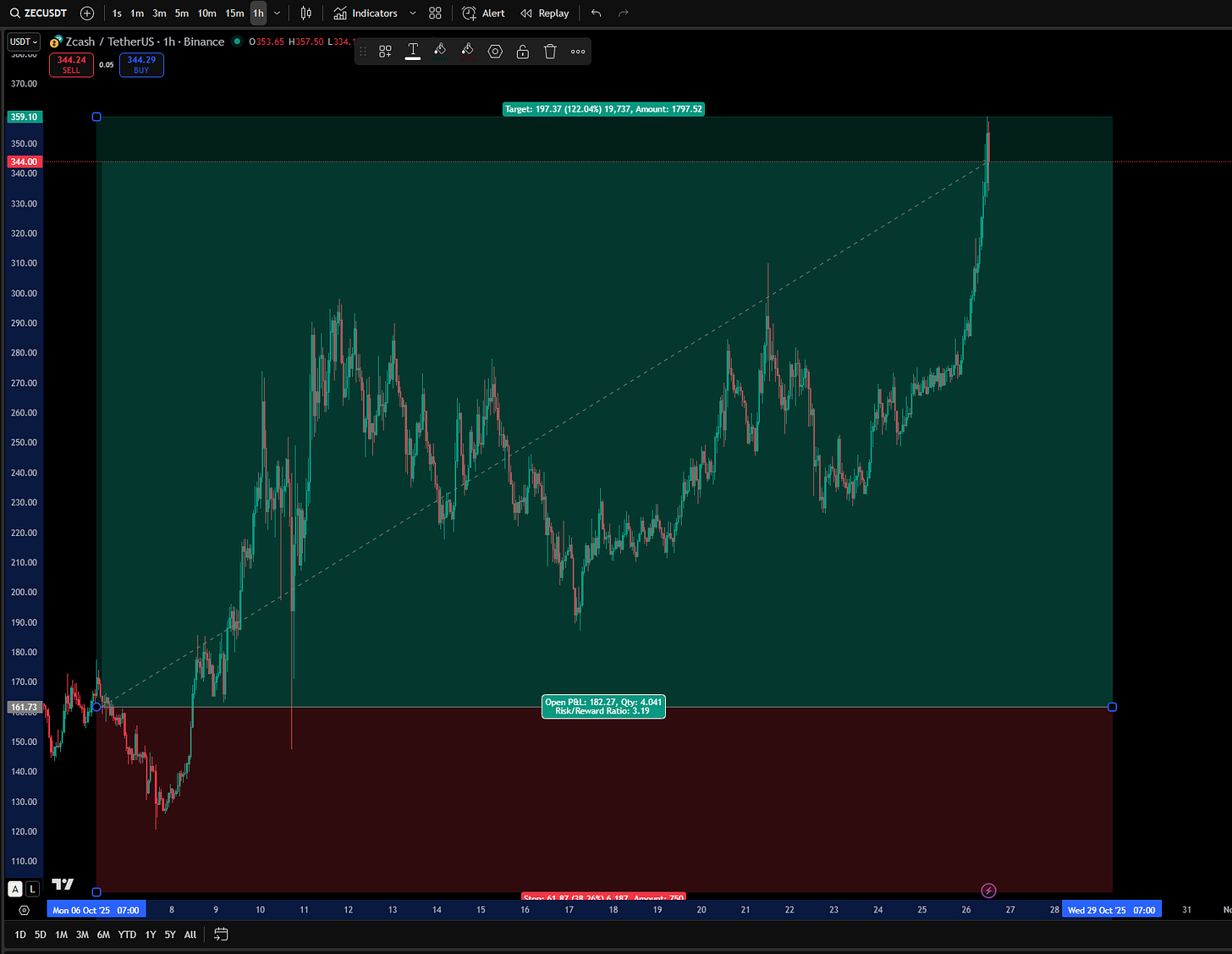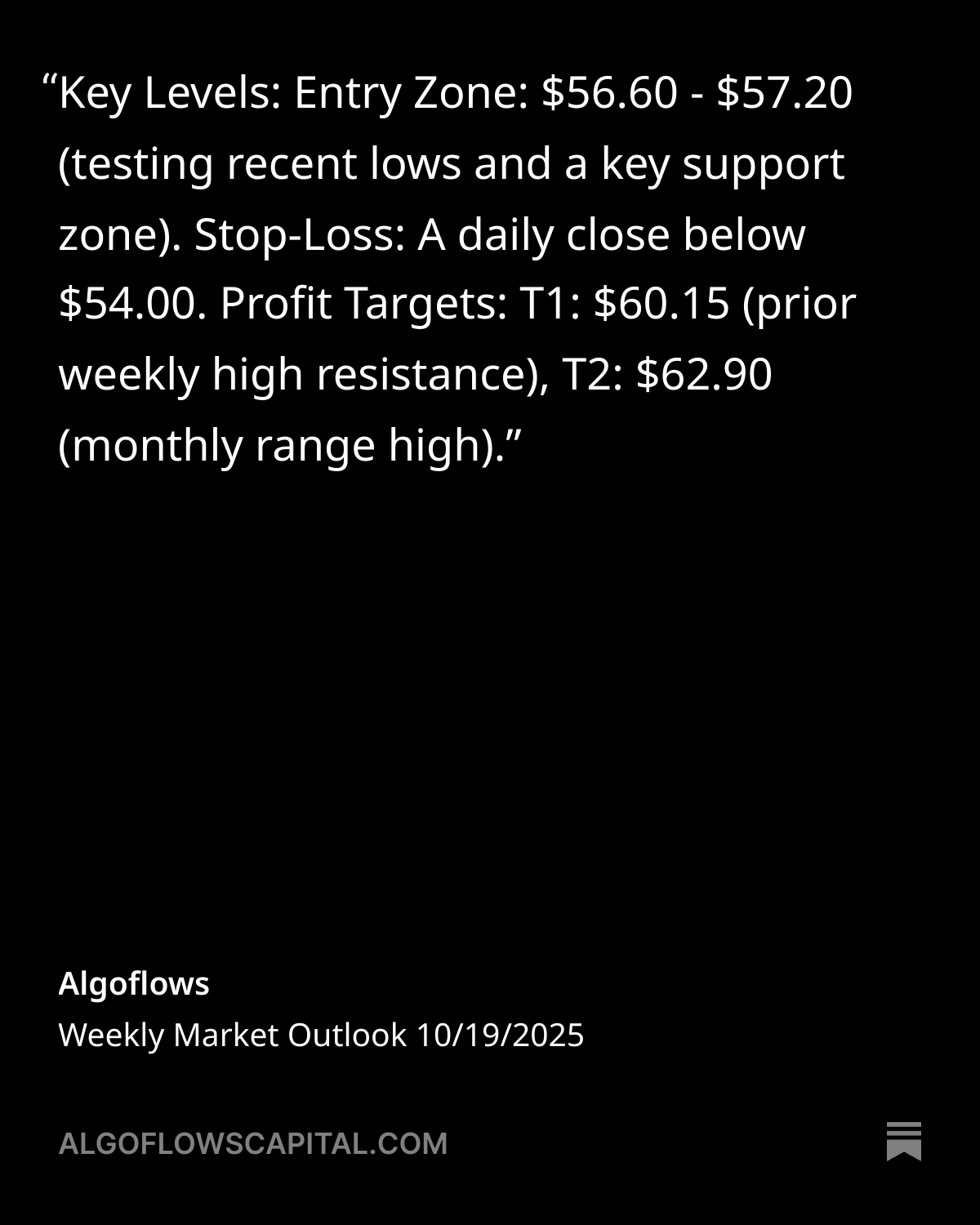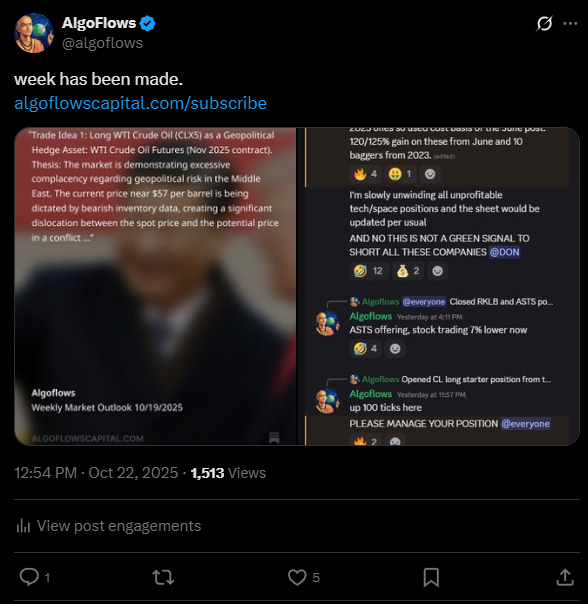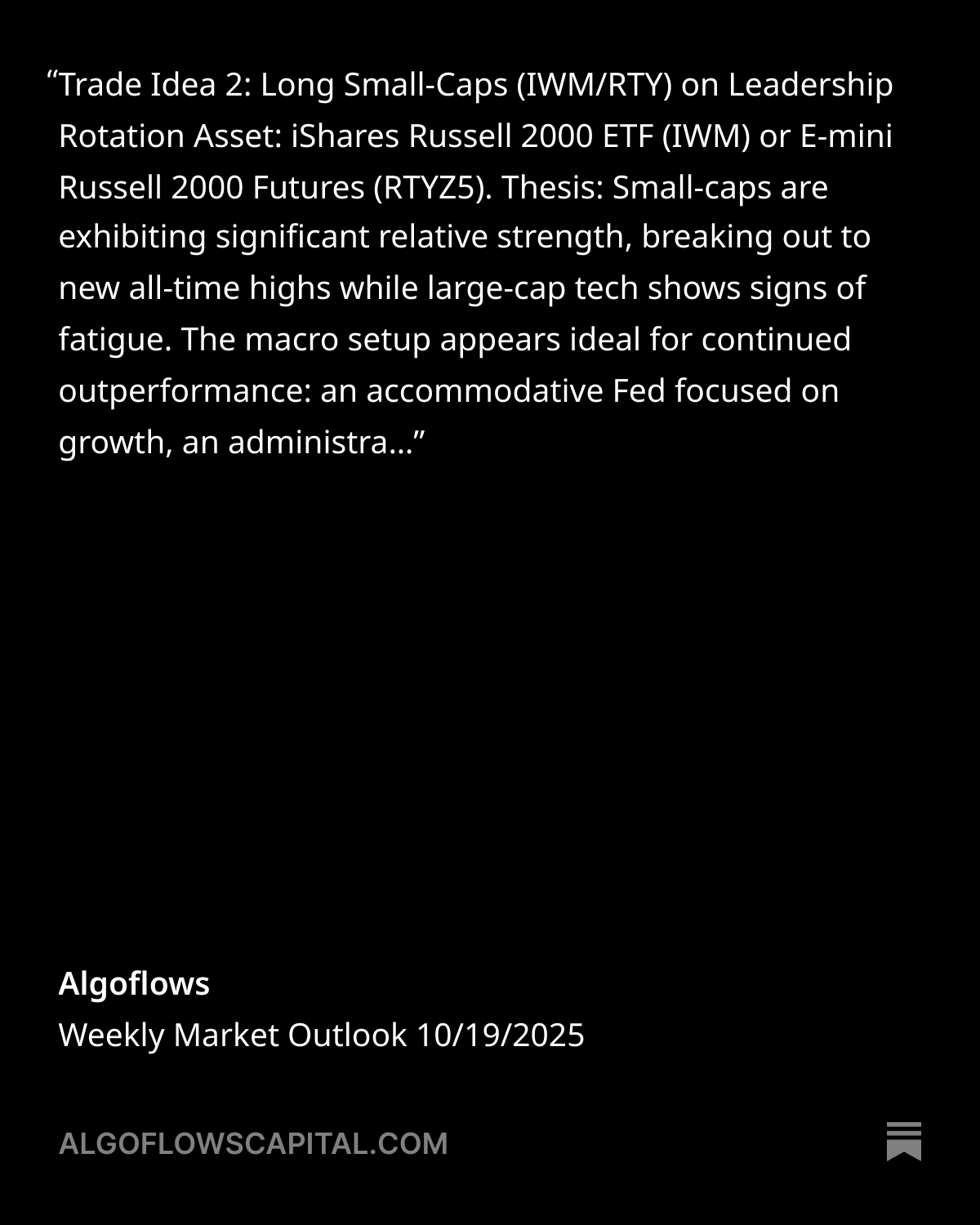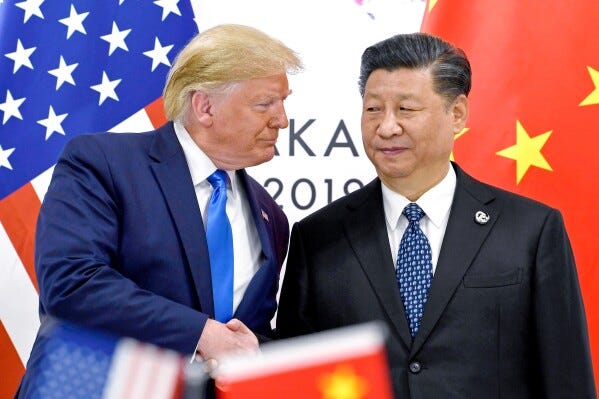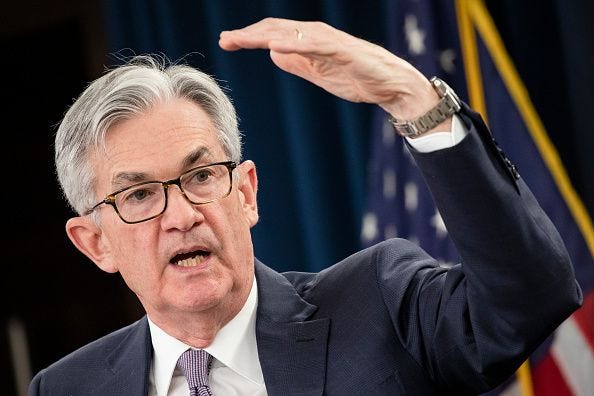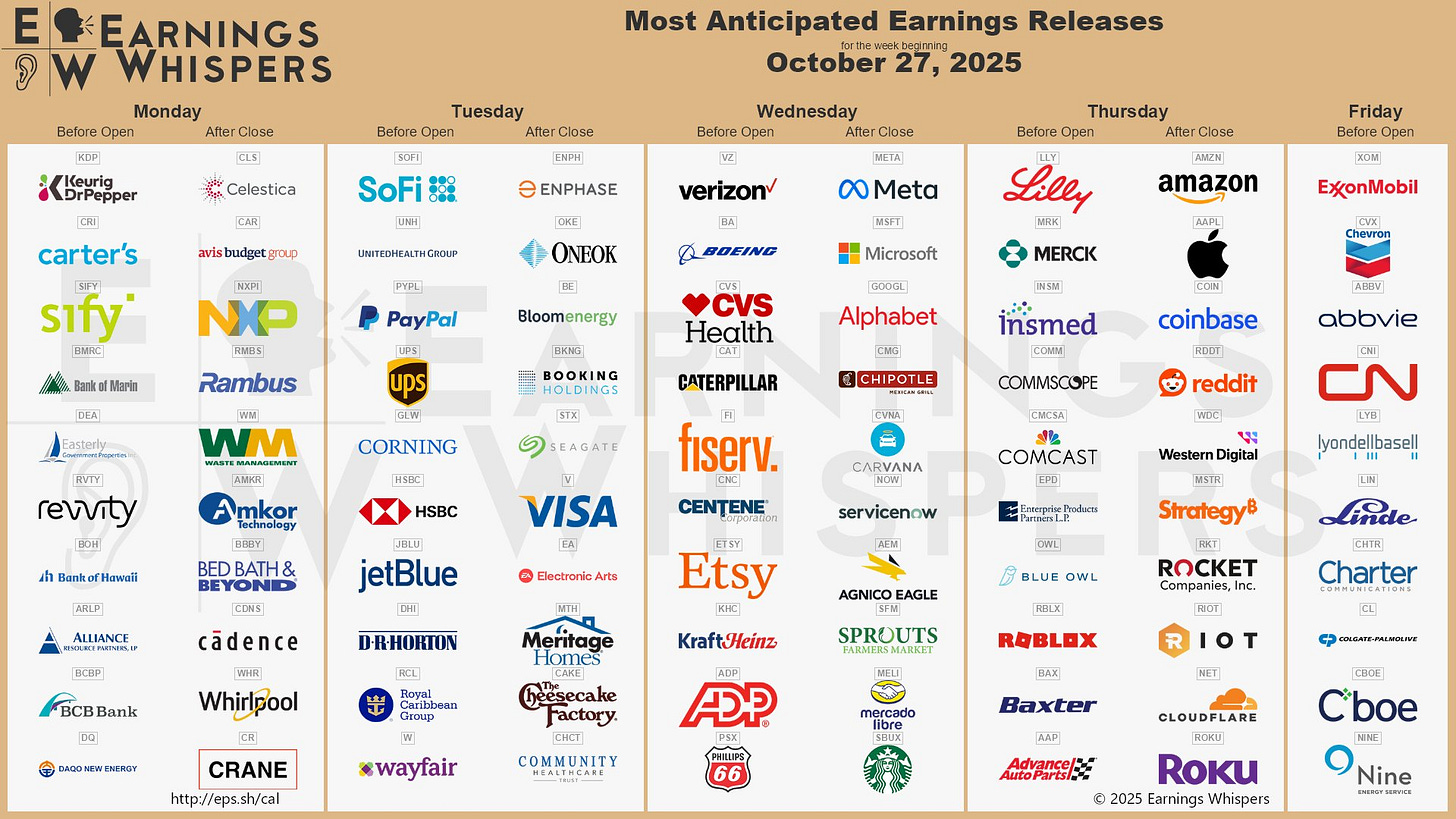Weekly Market Outlook 10/26
Dissenting ascent
Hello traders,
Hope everyone had a great weekend.
First off, Zcash (ZECUSDT) is now up 122% since our entry on 5th October.
Realtime Discord access with equity positions tracker, intraday orderflow & option dealer summaries included with the paid newsletter membership . Click here to subscribe.
Both core ideas from last week’s plan that worked out excellently were the Crude oil long and the RTY/IWM long
The Five Forces Driving the Market
Macro Setup: The Five Forces Quietly Rewriting Pricing.
Astute investors are often paid to anticipate market shifts before they become mainstream news. As the fourth quarter unfolds, the market’s direction is increasingly being dictated not by what exists, but by what might be politically reshaped. Five fundamental drivers are quietly influencing returns, creating a complex backdrop for the pivotal events of the coming week.
Persistent Fiscal Deficits: The U.S. primary deficit, which excludes interest payments, remains above 4 percent of the nation’s gross domestic product, even with historically high tax receipts. Counterintuitively, a drop in nominal interest rates may not offer relief. Because the Treasury must refinance its debt on a short cycle, a one percentage point decline in yields would mechanically add an estimated $250 billion in net interest expenses over a five year period. This dynamic causes the deficit to widen automatically, leading the bond market to demand a higher premium for holding long term debt.
Shifting Labor Market Optics: The U.S. labor force has expanded by an estimated 1.1 million workers in 2025, largely due to immigration. As a result, the economy now needs to generate only about 35,000 new jobs per month to keep the unemployment rate steady. This provides the Federal Reserve with political justification to signal that the labor market is cooling, potentially paving the way for a rate cut without an official recession. The central bank’s focus appears to have functionally shifted toward managing the unemployment rate rather than the economy’s overall output gap.
The Theater of Tariff Negotiations: Recent proposals for 100 percent tariffs are widely seen as an initial negotiating position rather than a final policy. The substantive discussions are centered on critical materials like antimony, rare earth quotas, and commitments for agricultural purchases. A partial rollback of the tariff threat could reduce headline inflation by an estimated 0.35 percentage points through its effect on consumer prices. This would hand the Fed a convenient public narrative of “disinflation” that could last into 2026, regardless of underlying price pressures in the services sector.
Uncertainty Over Fed Leadership: Federal Reserve Chairman Jerome Powell’s term ends in January 2026. The White House has reportedly considered candidates who might place a greater emphasis on the employment side of the central bank’s dual mandate over price stability. In response, the market has begun to price a 15 to 20 basis point “independence risk premium” into 5 year inflation protected securities, reflecting concerns about the future direction of monetary policy.
A Resurgence of Systemic Liquidity: The Federal Reserve’s program of quantitative tightening is concluding. Concurrently, the Treasury is expected to reduce its issuance of short term bills to manage optics around the debt ceiling. The net result of these actions is an estimated $450 billion in reserves flowing back into the financial system by March 2026. This represents a form of quiet, indirect quantitative easing that is not captured by most consensus economic models but is likely to affect asset classes with high sensitivity to balance sheets, such as cryptocurrencies and small capitalization stocks.
The combination of these five forces points to a period of synthetic monetary easing, stronger fiscal stimulus, and slower productivity growth. This mixture can serve as a powerful catalyst for nominal asset prices while creating a headwind for future real returns.
Take advantage of APEX’s 80% promo code and pass account in one day. Also Use code ALGO or alternatively just click the button below
I’m also giving away any size Apex accounts for free for 3 random people who like and restack this post . Contest ends this Friday.
Federal Reserve Decision Looms
The base case scenario, with a 95 percent probability, is for a 25 basis point rate cut with a 9 to 1 vote, with Governor Michelle Bowman likely dissenting. The committee’s official statement is expected to change its description of job gains from “solid” to “moderating” to signal a softening labor market without causing alarm. The language on inflation remaining “somewhat elevated” is likely to stay, as the Fed will be hesitant to declare victory. Mr. Powell is also anticipated to announce the end of quantitative tightening, effective January 1, 2026, to be implemented via a three month taper.
Two less likely scenarios could move markets significantly:
Dovish Double (4 percent probability): A key verbal signal would be language such as, “further adjustments could well become appropriate at upcoming meetings.” This could cause the U.S. Dollar Index to fall by approximately 1.2 percent and the Nasdaq 100 to rise by 2.5 percent.
Hawkish Hold (1 percent probability): Should Mr. Powell state that “the Committee judges the policy stance to be well calibrated,” it would signal no immediate intention to cut. The market reaction could be a 4 percent drop in the S&P 500, a spike in the VIX volatility index above 25, and a 20 basis point jump in the 5 year Treasury yield.
A secondary factor to watch is the spread between the Secured Overnight Financing Rate and the Overnight Index Swap, which has widened on concerns about Treasury bill supply. Any hint from the Fed that it is comfortable with reserve scarcity could force markets to price in higher rates for 2026.
U.S. China Summit: What Is Already Agreed in the Back Channel
Based on preparatory documents and diplomatic channel discussions, senior staff have likely staged several agreements ahead of the leaders’ meeting:
Tariff Freeze: The current 20 percent Section 301 tariff rate is expected to be locked in place, while the threat of a 100 percent escalation will likely be quietly shelved.
Agricultural Purchases: China is anticipated to commit to buying approximately 18 million tonnes of U.S. soybeans over 12 months, a deal valued at around $7 billion.
Critical Minerals: China is expected to signal that export licenses for rare earths and antimony will remain predictable, while the U.S. will likely pause aggressive enforcement of domestic content rules for electric vehicle minerals for 30 days.
Technology Gray Zone: An export license for Nvidia’s H20 chip, a modified version of its H100, is expected to move forward. Dutch firm ASML is likely to receive licenses for spare parts for older tools, partially resuming the flow of semiconductor equipment under strict controls.
How to trade itA) Semis: Nvidia, AMD, Marvell. Every 10 percent incremental China revenue tends to translate to about 4 percent EPS lift for this group. The SOX index sits on 7.2 percent short interest. That is squeeze fuel. Upside map: 5,200 vs current 4,850.
B) Deere and CNH: higher China soybean demand is good for volume, but lower soybean price offsets. Net neutral on top line. Cleaner expression is long the crush spread (think SOYB vs DBA) not the OEMs.
C) Defense: RTX, LMT. The antimony access deal does not reduce Pentagon urgency around critical minerals security. Names linked to domestic antimony and strategic metals production such as PPTA, UEC, ARR keep their bid whether or not the summit headline sounds friendly.
MEGA CAP EARNINGS: ONLY WAY OUT IS THROUGH
This week we are in the thick of the earnings action with Meta, Microsoft, Alphabet, Amazon and Apple reporting post FOMC.
• If three of the MAG7 names beat and raise guidance by more than 5 percent, the Nasdaq 100 can climb about 4 percent. That would likely push more than 75 percent of index members above their 20 day moving average, which is a classic trigger for a melt up.
• If two of them miss and guide lower, the Nasdaq 100 can fall around 6 percent. Cross asset volatility can jump above 30. Systematic funds could pull roughly 45 billion dollars of gross exposure, based on quantitative models at major banks.
• If results are mixed, capital rotates instead of fleeing. Index level performance can look quiet while single stock options remain rich. In that scenario, selling index volatility and buying single name volatility often pays.
Dollar, rates, commodities and Volatility
The Dollar: How Reserve Privilege Erodes in Real Time
The U.S. Dollar Index (DXY) currently appears overvalued by about 8 percent relative to its fair value estimates. Positioning has also shifted, with net long positions in the dollar among futures traders falling from 28,000 to 11,000 contracts in two weeks, the fastest unwind since March 2020. Over the next 24 months, a combination of fiscal dominance and a politically influenced Fed could lead to a weaker dollar, with a potential target in the 88 to 90 range for the DXY by 2027. This trend is already underway; China’s cross border digital yuan platform has contributed to a rise in commodity invoicing in CNY, permanently reducing some structural demand for dollars.
Rates Curve: Who Wins, Banks or Long Duration Tech
The yield curve has been flattening recently due to a rising term premium rather than expectations of a more hawkish Fed. A dovish Fed combined with a tariff truce could lead to a steeper curve, which would benefit banks and small cap stocks. A more hawkish Fed stance alongside fiscal concerns could cause the curve to flatten further, signaling a potential profit recession and favoring long duration technology stocks on a relative basis. The key indicator to watch is the 10 year TIPS breakeven rate; a sharp rise in near term inflation expectations could signal a rotation out of bonds and gold and into assets like copper.
Equity Rotation: Breadth, Style, and Single Name Velocity
Currently, 63 percent of stocks are trading above their 200 day moving average. A broad market rally, or “melt up,” historically requires this figure to cross 75 percent. This would necessitate about two weeks of strongly positive market breadth. Depending on the week’s macro inputs, market leadership could shift between small caps and cyclicals, mega cap tech, or low volatility defensive stocks.
Specific company setups are also drawing attention. Amazon (AMZN) is trading at a historically low price to earnings multiple, and analysts see a potential 35 percent upside if its cloud and automation initiatives boost margins. Sasol (SSL), a South African chemical and energy company, appears undervalued with potential for a 60 percent jump in earnings on a modest recovery. Perpetua Resources (PPTA) has benefited from U.S. government support for domestic antimony production, a strategic metal.
Commodities: Microstructure Where the Edge Still Lives
In energy markets, the futures curve for Brent crude is signaling oversupply, and institutional positioning is not overextended. In industrial metals, copper warehouse stocks on the London Metal Exchange are down 28 percent year to date, and futures contracts show the deepest backwardation since 2022, a sign of extremely tight physical supply. For precious metals, gold lease rates have flipped negative, indicating physical scarcity in London, while central bank buying remains robust. A spike in these lease rates could force short sellers to cover, potentially targeting a price of $4,500 per ounce within six months.
Volatility Complex: Where the Options Market Is Quietly Paying You Twice
The VIX term structure shows a significant contango, meaning that options protecting against future volatility are expensive. Skew, which measures the relative price of puts versus calls, indicates that investors are overpaying for downside protection. Dealer positioning in S&P 500 options is likely to keep the index in a narrow range until Friday’s expiration. Afterward, the market could become susceptible to a much larger move. In crypto markets, Bitcoin volatility is relatively subdued, but the asset is coiled between key technical levels. A break above $125,000 could trigger a short squeeze, while a drop below $104,000 could lead to a rapid decline toward $90,000.
Four primary scenarios based on the models.
Melt-Up (35 %):
Overweight: small-caps (IWM), semis (SOX), copper (COPX), crypto (BTC).
Underweight: USD, staples, utilities.
Keep reading with a 7-day free trial
Subscribe to Algoflows Capital to keep reading this post and get 7 days of free access to the full post archives.


